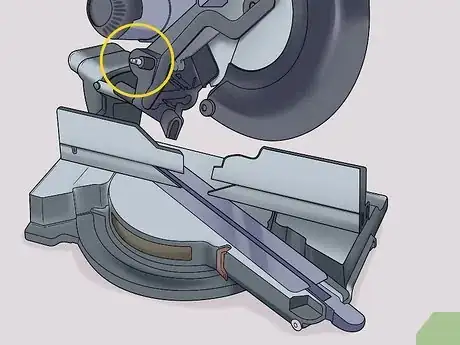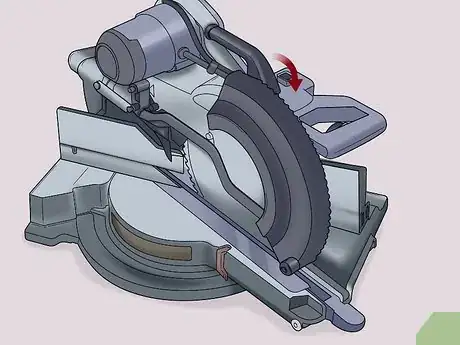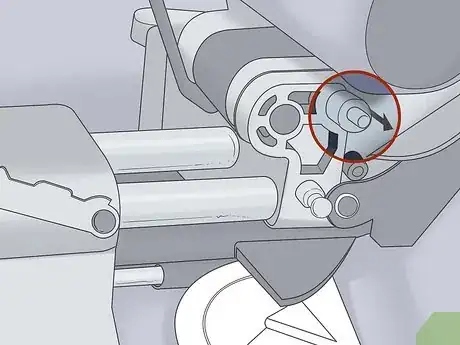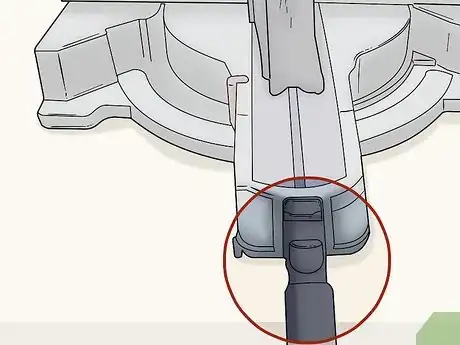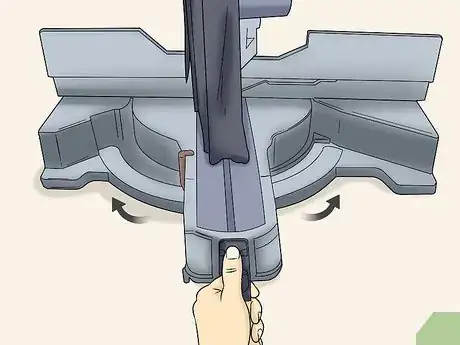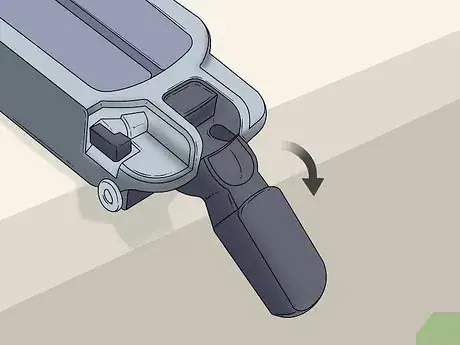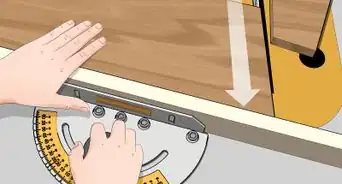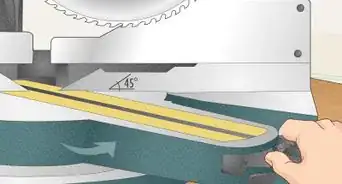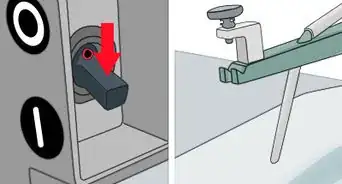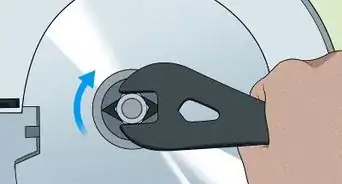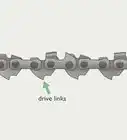This article was co-authored by wikiHow staff writer, Eric McClure. Eric McClure is an editing fellow at wikiHow where he has been editing, researching, and creating content since 2019. A former educator and poet, his work has appeared in Carcinogenic Poetry, Shot Glass Journal, Prairie Margins, and The Rusty Nail. His digital chapbook, The Internet, was also published in TL;DR Magazine. He was the winner of the Paul Carroll award for outstanding achievement in creative writing in 2014, and he was a featured reader at the Poetry Foundation’s Open Door Reading Series in 2015. Eric holds a BA in English from the University of Illinois at Chicago, and an MEd in secondary education from DePaul University.
This article has been viewed 108,374 times.
Learn more...
Understanding how a miter saw locks and unlocks is essential to operating the saw safely. To unlock the head of the saw, press the handle on the saw down and pull the pin under the handle to release the lock and move your blade up and down. To unlock the guide rail, press the button on the end of the black lever at the end of the guide rail and adjust the angle before pressing the lever down to lock it in place. Remember to always take the proper safety precautions when operating a power tool and always keep your fingers away from the blade. Always lock a miter saw’s rail and head when you aren’t using it.
Steps
Using the Lock Pin to Release the Head
-
1Find the metal pin sticking out underneath the handle on the rail. Stand behind the saw blade and locate the handle at the top of the saw. Follow the handle down to the rail that connects the head of the saw to the base. This rail is made of thick metal and runs vertically from the top to the bottom of the saw. On this rail, look for a small metal pin sticking out of the side. This pin is usually on the inside of the rail, but on older models it may be on the exterior side.[1]
- The lock pin is used to unlock the head of the saw so that you can move the blade up and down, but the guide rail will remain locked. You use the lever at the end of the guide rail to adjust the angle at the cut.
- If you have an older saw, this pin may be a knob. If you have knob lock pin, turn it counterclockwise to pull it out and clockwise to push it in.
Tip: Most brands of miter saw have a lock pin that is similar to the Dewalt pin. This method will unlock most miter saws, regardless of the brand.
-
2Press the handle down 2–3 in (5.1–7.6 cm) and hold it in place. With your hand firmly on the handle, press the saw down a little and hold it in place. You cannot unlock the saw without keeping the blade held down.[2]Advertisement
-
3Pull the pin out 1–2 in (2.5–5.1 cm) to unlock the saw. With the handle held down, grip the pin with your free hand. Gently pull it out away from the rail that it is connected to. Pull it out as far as it will go, normally 1–2 inches (2.5–5.1 cm), and release the pin. Your saw is now in the unlocked position and you can move the blade freely.[3]
- Whenever the pin is sticking out, the saw is unlocked. Always check this pin before picking your saw up to move it somewhere else.
- On a Dewalt compound sliding saw, pulling this pin out allows you to move the saw up and down on the rail that it’s attached to as well. To lock the rail in place, twist the knob on top of the large bracket where the rails slide back and forth. Turn this knob clockwise to tighten it in place.[4]
-
4Press the handle all the way down and press the pin in to lock it. To lock the saw, press the handle down until the blade is as low as it can go. Then, press the lock pin back into the rail to secure the blade in place. Ensure that the saw is locked by pulling up on the handle with the pin pushed in. If the handle doesn’t move, your saw is locked.[5]
- Always lock the saw when you aren’t using it. It is dangerous to leave a saw unlocked, even if it isn’t plugged in or running.
Moving the Guide Rail on a Compound Saw
-
1Inspect the end of the guide rail and look for a black lever. To adjust the guide rail that guides the saw through your cut, go to the front of the saw. Follow the horizontal guide rail to the tip furthest from the handle. Look for a black lever that is sticking out of the saw at the end. This is the lock handle, which is used to adjust the location of the guide rail.[6]
- The guide rail is the horizontal platform that the saw blade drives in to. On compound miter saws, this rail can be adjusted so that you can make bevel cuts, which are precise cuts that are made at an angle other than 90-degrees.
Tip: This type of lever is unique to Dewalt saws; other brands usually use a latch and a knob to adjust the guide rail. To unlock these rails, flip the tab at the end of the guide rail and turn the knob clockwise or counterclockwise to adjust it. Flip the latch to its original position to lock the rail in place.
-
2Press the button on top of the black lever and move the rail. If the lever is pointing down, flip it up so that it is flush with the guide rail. Then, inspect the top of the lever and look for a small, black button. This button releases the locking mechanism in the guide rail. Press this button and hold it down with your finger. Then, move the rail freely from side to side to adjust the angle of your cut.[7]
- You cannot move the guide rail if the lever is in the down position.
- If you need to make a cut at an exact angle, follow the angle guide at the base of the miter saw to line your blade up with a specific angle.
-
3Release the button and push the lever down to lock the rail. Once your compound miter saw is resting at the desired angle, release the button. Then, press down on the end of the lever to snap it into the locked position. When the lever is pointing down, the guide rail is locked and your cutting angle will not move as you make your cuts.[8]
- The lever has 2 positions—up and down. You will feel it snap into place every time that you move it.
Warnings
- Keep your fingers 6–12 inches (15–30 cm) away from the saw blade when the saw is plugged in. Never reach under the blade when you’re operating the saw.⧼thumbs_response⧽
- Always wear the proper safety equipment when operating a power tool. Wear protective eyewear if you’re cutting wood to avoid blowing sawdust into your eyes. If you’re cutting metal, wear a welding mask, rubber apron, and rubber gloves to protect yourself. Wear protective headphones to avoid hearing loss while you’re operating the saw.⧼thumbs_response⧽
- Always unplug the saw when you’re changing the blades in the event that you accidentally turn it on.⧼thumbs_response⧽
References
- ↑ http://pdf.lowes.com/useandcareguides/885911231602_use.pdf
- ↑ http://pdf.lowes.com/useandcareguides/885911231602_use.pdf
- ↑ http://pdf.lowes.com/useandcareguides/885911231602_use.pdf
- ↑ https://youtu.be/l5AE_GaBovg?t=225
- ↑ http://pdf.lowes.com/useandcareguides/885911231602_use.pdf
- ↑ https://youtu.be/SYcLPyRNhpE?t=159
- ↑ https://youtu.be/SYcLPyRNhpE?t=169
- ↑ https://youtu.be/SYcLPyRNhpE?t=174
- ↑ https://youtu.be/l5AE_GaBovg?t=196
